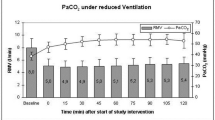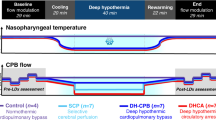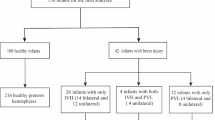Abstract
Perinatal brain injury has been associated with impaired cerebral blood flow (CBF) pressure autoregulation. The brain of 3- to 5-d-old rat pups is immature and similar to that of a preterm infant, and therefore we tested cerebral vasoreactivity in that animal. CBF pressure autoregulation was tested in 20 Wistar pups during normocapnia and hypercapnia, respectively. Hypotension was induced by hemorrhage and cerebral perfusion was monitored with laser Doppler flowmetry and near-infrared spectroscopy. Systolic blood pressure was measured noninvasively from the tail. During normocapnia, the autoregulatory plateau was narrow. Resting systolic blood pressure (SBP) was 39.2 mm Hg and CBF remained constant until SBP decreased below 36.0 mm Hg (SE 0.8). Below the lower limit, CBF declined by a mean of 2.7% per mm Hg [95% confidence interval (CI), 2.4–3.0%], and hemoglobin difference (HbD) and total hemoglobin (HbT) changed proportionally to CBF. After inhalation of carbon dioxide, CBF increased significantly by a mean of 17.7% (95% CI, 13.7–22.8%). The CBF-CO2 reactivity was estimated to 13.4% per kPa (95% CI, 2–24.8%), p = 0.026. Over the range of SBP (6–54 mm Hg), a linear relationship between CBF and SBP was found during hypercapnia, indicating abolished pressure autoregulation. A linear correlation between CBF and HbD was found (r = 0.80). CBF pressure autoregulation and reactivity to CO2 operate in the newborn rat. This model may be useful for future investigations concerning perinatal pathophysiology in the immature brain.
Similar content being viewed by others
Log in or create a free account to read this content
Gain free access to this article, as well as selected content from this journal and more on nature.com
or
Abbreviations
- CBF:
-
cerebral blood flow
- HbD:
-
hemoglobin difference
- HbT:
-
total hemoglobin
- LDF:
-
laser Doppler flowmetry
- NIRS:
-
near-infrared spectroscopy
- SBP:
-
systolic blood pressure
References
Volpe JJ 1997 Brain injury in the premature infant. Neuropathology, clinical aspects, pathogenesis, and prevention. Clin Perinatol 24: 67–587
Pryds O 1991 Control of cerebral circulation in the high-risk neonate. Ann Neurol 30: 21–329
Pryds O, Greisen G, Lou H, Friis-Hansen B 1989 Heterogeneity of cerebral vasoreactivity in preterm infants supported by mechanical ventilation. J Pediatr 115: 38–645
Tsuji M, Saul JP, du Plessis A, Eichenwald E, Sobh J, Crocker R, Volpe JJ 2000 Cerebral intravascular oxygenation correlates with mean arterial pressure in critically ill premature infants. Pediatrics 106: 25–632
Fujimura M, Salisbury DM, Robinson RO, Howat P, Emerson PM, Keeling JW, Tizard JP 1979 Clinical events relating to intraventricular haemorrhage in the newborn. Arch Dis Child 54: 09–414
Cooke RW 1981 Factors associated with periventricular haemorrhage in very low birthweight infants. Arch Dis Child 56: 25–431
Levene MI, Fawer CL, Lamont RF 1982 Risk factors in the development of intraventricular haemorrhage in the preterm neonate. Arch Dis Child 57: 10–417
Volpe JJ 1989 Intraventricular hemorrhage in the premature infant—current concepts. Part I. Ann Neurol 25: 109–11
Volpe JJ 1989 Intraventricular hemorrhage in the premature infant—current concepts. Part II. Ann Neurol 25: 09–16
Haggendal E, Johansson B 1965 Effects of arterial carbon dioxide tension and oxygen saturation on cerebral blood flow autoregulation in dogs. Acta Physiol Scand Suppl 258: 7–53
Plum F, Posner JB, Troy B 1968 Cerebral metabolic and circulatory responses to induced convulsions in animals. Arch Neurol 18: 1–13
Nilsson B, Agardh CD, Ingvar M, Siesjo BK 1981 Cerebrovascular response during and following severe insulin-induced hypoglycemia: CO2-sensitivity, autoregulation, and influence of prostaglandin synthesis inhibition. Acta Physiol Scand 111: 55–463
Paulson OB, Strandgaard S, Edvinsson L 1990 Cerebral autoregulation. Cerebrovasc Brain Metab Rev 2: 61–192
Szymonowicz W, Walker AM, Yu VY, Stewart ML, Cannata J, Cussen L 1990 Regional cerebral blood flow after hemorrhagic hypotension in the preterm, near-term, and newborn lamb. Pediatr Res 28: 61–366
Laptook A, Stonestreet BS, Oh W 1982 Autoregulation of brain blood flow in the newborn piglet: regional differences in flow reduction during hypotension. Early Hum Dev 6: 9–107
Hernandez MJ, Brennan RW, Bowman GS 1980 Autoregulation of cerebral blood flow in the newborn dog. Brain Res 184: 99–202
Pasternak JF, Groothuis DR 1985 Autoregulation of cerebral blood flow in the newborn beagle puppy. Biol Neonate 48: 00–109
Tweed WA, Cote J, Wade JG, Gregory G, Mills A 1982 Preservation of fetal brain blood flow relative to other organs during hypovolemic hypotension. Pediatr Res 16: 37–140
Szymonowicz W, Walker AM, Cussen L, Cannata J, Yu VY 1988 Developmental changes in regional cerebral blood flow in fetal and newborn lambs. Am J Physiol 254: 52–H58
Himwich WA 1973 Problems in interpreting neurochemical changes occurring in developing and aging animals. Prog Brain Res 40: 3–23
Whitelaw A, Thoresen M 2000 Antenatal steroids and the developing brain. Arch Dis Child Fetal Neonatal Ed 83: 154–157
Fumagalli M, Mosca F, Moos Knudsen G, Greisen G 2004 A newborn rat model for the study of cerebral hemodynamics by near-infrared spectroscopy and laser-Doppler flowmetry in the immature brain. Biol Neonate 85: 12–120
Fumagalli M, Mosca F, Knudsen GM, Greisen G 2004 Transient hyperoxia and residual cerebrovascular effects in the newborn rat. Pediatr Res 55: 80–384
Pedersen TF, Paulson OB, Nielsen AH, Strandgaard S 2003 Effect of nephrectomy and captopril on autoregulation of cerebral blood flow in rats. Am J Physiol Heart Circ Physiol 285: 1097–H1104
Golding EM, Steenberg ML, Contant CF Jr, Krishnappa I, Robertson CS, Bryan RM Jr 1999 Cerebrovascular reactivity to CO(2) and hypotension after mild cortical impact injury. Am J Physiol 277: 1457–H1466
Lee JG, Hudetz AG, Smith JJ, Hillard CJ, Bosnjak ZJ, Kampine JP 1994 The effects of halothane and isoflurane on cerebrocortical microcirculation and autoregulation as assessed by laser-Doppler flowmetry. Anesth Analg 79: 8–65
Nehlig A 1994 Effects of respiratory stimulants on cerebral metabolism and blood flow. Biol Neonate 65: 58–264
Kuroda Y, Murakami M, Tsuruta J, Murakawa T, Shiroyama Y 2000 Effects of sevoflurane and isoflurane on the ratio of cerebral blood flow/metabolic rate for oxygen in neurosurgery. J Anesth 14: 28–134
Gross PM, Marcus ML, Heistad DD 1980 Regional distribution of cerebral blood flow during exercise in dogs. J Appl Physiol 48: 13–217
Fabricius M, Akgoren N, Dirnagl U, Lauritzen M 1997 Laminar analysis of cerebral blood flow in cortex of rats by laser-Doppler flowmetry: a pilot study. J Cereb Blood Flow Metab 17: 326–1336
Tsuji M, duPlessis A, Taylor G, Crocker R, Volpe JJ 1998 Near infrared spectroscopy detects cerebral ischemia during hypotension in piglets. Pediatr Res 44: 91–595
Vannucci RC, Towfighi J, Heitjan DF, Brucklacher RM 1995 Carbon dioxide protects the perinatal brain from hypoxic-ischemic damage: an experimental study in the immature rat. Pediatrics 95: 68–874
Acknowledgements
The authors thank Professor Olaf Paulson for assistance with the application of the software to estimate the lower autoregulatory limit.
Author information
Authors and Affiliations
Additional information
Supported by the Savværksejer Jeppe Juhl og hustru Ovita Juhl's Foundation gave.
Rights and permissions
About this article
Cite this article
Pryds, A., Tønnesen, J., Pryds, O. et al. Cerebral Pressure Autoregulation and Vasoreactivity in the Newborn Rat. Pediatr Res 57, 294–298 (2005). https://doi.org/10.1203/01.PDR.0000148714.51310.5E
Received:
Accepted:
Issue date:
DOI: https://doi.org/10.1203/01.PDR.0000148714.51310.5E
This article is cited by
-
The effects of sodium bicarbonate infusion on cerebrovascular function in newborn pigs
Pediatric Research (2022)
-
Does prolonged severe hypercapnia interfere with normal cerebrovascular function in piglets?
Pediatric Research (2018)
-
Dynamic Spatio-Temporal Imaging of Early Reflow in a Neonatal Rat Stroke Model
Journal of Cerebral Blood Flow & Metabolism (2013)
-
Polynitroxyl Albumin and Albumin Therapy after Pediatric Asphyxial Cardiac Arrest: Effects on Cerebral Blood Flow and Neurologic Outcome
Journal of Cerebral Blood Flow & Metabolism (2012)
-
Age-dependent effects of gradual decreases in cerebral perfusion pressure on the neurochemical response in swine
Intensive Care Medicine (2010)



